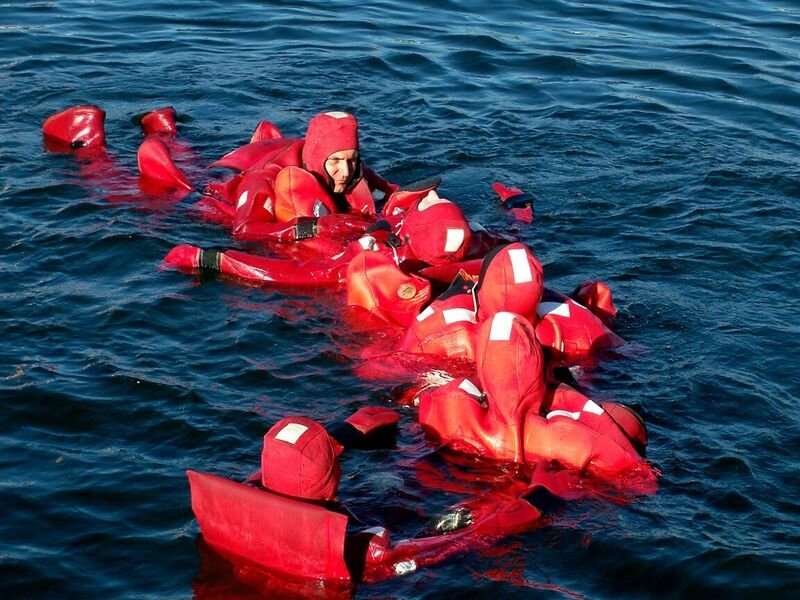Maritime training facilities across the U.S. enroll marine clients from first time deckhands to multiple renewal masters and everything in between. From brownwater to blue, the facilities specialize in getting mariners trained for STCW (Standards of Training, Certification and Watchkeeping), emergency response, shipboard safety, basic safety, marine fire and a litany of other necessities today’s mariner needs to work in the marine industry safely and legally.
“Maintenance and safety training is something you do to keep the boat operating,” said Jon Kjaerulff, director, Fremont Maritime, Seattle. “Safety training is just as important as maintenance. But if you’re going to give someone a duty, you should train them to do it before you assign it to them.”

Most training institutes offer Basic Marine Firefighting courses. Fremont Maritime photo
Training facilities such as Fremont must keep up to date with new requirements such the Coast Guard’s 46 CFR Subchapter M that requires, for the first time, towing vessels to carry certificates of inspection (COI). The new rule, which went into effect in July 2016, requires all towing vessels of 26' or more in length to “be under the control of an officer who holds a first class pilot’s license or endorsement for that route, or who meet requirements related to the type of barge being towed.”
“And you have to have safety management training for your crew,” said Kjaerulff. “Subchapter M has forced companies to be more proactive when it comes to safety.”
The Subchapter M training will be the responsibility of the inland companies, not the individual mariners. “A company will have their Towing Safety Management System that will have the type of training each crewmember needs. “Most of the burden falls on the companies,” said Kjaerulff. “They can either do the training in house or come to a facility like ours to do it.”

In addition to digital charting, a knowledge of paper charts is valuable. Sea School photo
Subchapter M has a multitude of moving parts, some of which are still being worked out. “The wording for some of the Subchapter M requirements is ambiguous,” said Kjaerulff. “It might say something like you ‘have to train to put out a fire.’ Well, that could be interpreted in several ways. Do you want to train them to put out a fire on inland vessels?”
Some of the upcoming courses at Fremont include Basic Training (April 10-14), Basic Training Refresher (April 8-10), Basic Firefighting (April 13-14), Advanced Firefighting (March 13-16), VPDSD (Vessel Personnel with Designated Security Duties — March 13) and 24-Hour Hazwoper (Hazardous Waste Operations and Emergency Response — April 3-5).
Fremont also has a course called Crisis and Crowd Management Training. The course is for any crew member who has responsibility for passengers’ safety. In the workboat world that would include crewboats, small passenger vessels to large ferries carrying hundreds of people in ports such as Seattle, Boston and New York. “We concentrate on stress management and human behavior,” said Kjaerulff. “We want to know if a crewmember can work under pressure in a crisis situation where hundreds of people may be involved. I wish I taught the class more.”

Camaraderie is part of any course. Sea School photo.
The marine industry will never be perceived as cool or sophisticated like the technology industry is, for example. It’s perception, not necessarily reality. Some of that has to do with savvy industries that know how to market themselves, whereas the marine industry has mostly been content with flying under the radar. “It can be a struggle to attract high school kids,” said Capt. Ken Wahl, Sea School’s vice president. “We’ve had some success with the Propeller Club here in Tampa, and in Toledo (Ohio) we have some nautical classes in the magnet school.”
In addition to Toledo, Sea School has seven other campuses east of the Mississippi River — New York; St. Petersburg, Fla., Fort Lauderdale, Fla.; Jacksonville, Fla.; Panama City, Fla.; Charleston, S.C.; and Bayou La Batre, Ala. The company has more than 50 USCG approved courses, plus license renewals, a Mariner’s Drug Testing Program, USCG Application Consultation and Submission Services and more.
For marine companies across the industry, attracting, training and retaining young people in the industry is a constant struggle.

Some courses are more physically strenuous than others. Fremont Maritime photo
“We’re finding that there is a large desire for young folks to get in this industry,” said Wahl. “We try to tell the kids exactly what they are going to experience, what kind of money they will make, the cyclical nature of the offshore industry, for example. That kind of thing.”
Wahl said he is a member of the Coast Guard’s National Offshore Advisory Committee, a “think tank that tries to look ahead to what new challenges are coming up.” He can bring what he learns on the advisory board back to Sea School, helping him keep up with what’s going to be expected of tomorrow’s mariner.
Training isn’t cheap but most companies put up the money to train their employees. “The major companies know that training is part of the expense of owning a marine company,” said Kjaerulff.





